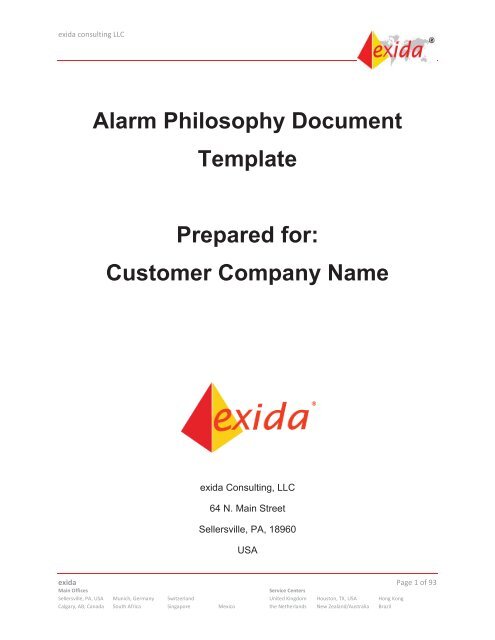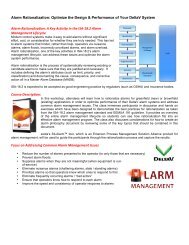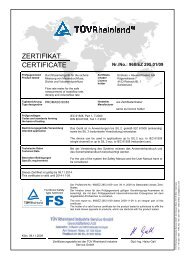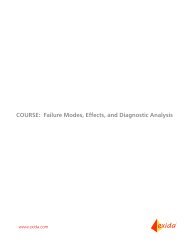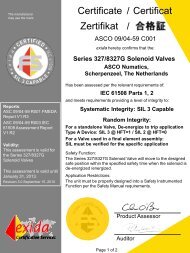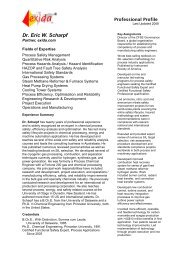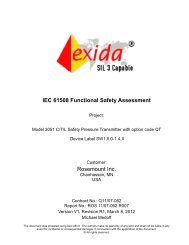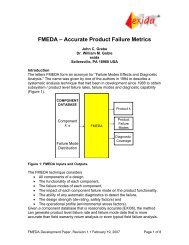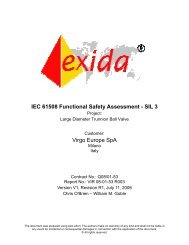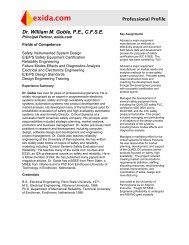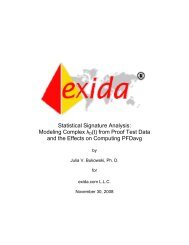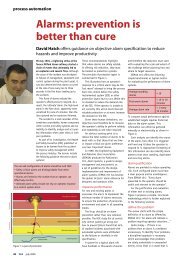Download a sample of the exida alarm philosophy template
Download a sample of the exida alarm philosophy template
Download a sample of the exida alarm philosophy template
Create successful ePaper yourself
Turn your PDF publications into a flip-book with our unique Google optimized e-Paper software.
<strong>exida</strong> consulting LLC<br />
Alarm Philosophy Document<br />
Template<br />
Prepared for:<br />
Customer Company Name<br />
<strong>exida</strong> Consulting, LLC<br />
64 N. Main Street<br />
Sellersville, PA, 18960<br />
USA<br />
<strong>exida</strong> Page 1 <strong>of</strong> 93<br />
Main Offices<br />
Service Centers<br />
Sellersville, PA, USA Munich, Germany Switzerland United Kingdom Houston, TX, USA Hong Kong<br />
Calgary, AB, Canada South Africa Singapore Mexico <strong>the</strong> Ne<strong>the</strong>rlands New Zealand/Australia Brazil
<strong>exida</strong> consulting LLC<br />
Customer Company Name Alarm Philosophy Document<br />
Distribution:<br />
This <strong>alarm</strong> <strong>philosophy</strong> <strong>template</strong> is <strong>the</strong> property <strong>of</strong> <strong>exida</strong>. It has been prepared and delivered<br />
solely for <strong>the</strong> development <strong>of</strong> an <strong>alarm</strong> <strong>philosophy</strong> document by:<br />
Customer Company Name<br />
Customer City, State, Zip<br />
With receipt <strong>of</strong> this document, recipient acknowledges and agrees that:<br />
i) The <strong>template</strong> will not be distributed in any format to persons / entities outside recipient’s<br />
company.<br />
ii) All <strong>of</strong> <strong>the</strong> information herein will be treated as confidential material with no less care than<br />
that afforded to your own company’s confidential material.<br />
Exida Page 2 <strong>of</strong> 93<br />
Main Offices<br />
Service Centers<br />
Sellersville, PA, USA Munich, Germany Switzerland United Kingdom Houston, TX, USA Hong Kong<br />
Calgary, AB, Canada South Africa Singapore Mexico <strong>the</strong> Ne<strong>the</strong>rlands New Zealand/Australia Brazil<br />
Rev 2/2011
<strong>exida</strong> consulting LLC<br />
Customer Company Name Alarm Philosophy Document<br />
Table <strong>of</strong> Contents<br />
1 PURPOSE AND USE OF AN ALARM PHILOSOPHY ................................................................ 9<br />
1.1 SCOPE .............................................................................................................................................. 9<br />
1.2 ASSUMPTIONS ................................................................................................................................. 10<br />
2 ALARM MANAGEMENT PRINCIPLES ............................................................................. 11<br />
2.1 PURPOSE AND GOALS OF THE ALARM SYSTEM ....................................................................................... 11<br />
2.2 OPERATOR NOTIFICATIONS ................................................................................................................ 11<br />
2.2.1 DEFINITION OF AN ALARM ............................................................................................................. 12<br />
2.2.2 OTHER NOTIFICATION TYPES .......................................................................................................... 12<br />
2.3 ALARM DESIGN PRINCIPLES ................................................................................................................ 13<br />
2.4 ALARM MANAGEMENT LIFECYCLE ....................................................................................................... 15<br />
3 TERMINOLOGY & REFERENCES ................................................................................... 17<br />
3.1 DEFINITIONS ................................................................................................................................... 17<br />
3.2 ACRONYMS & ABBREVIATIONS ........................................................................................................... 21<br />
3.3 INDUSTRY REFERENCES, STANDARDS, REGULATIONS, AND GUIDELINES ....................................................... 22<br />
3.4 RELATED SITE PROCEDURES, GUIDELINES, AND STANDARDS ..................................................................... 22<br />
4 ROLES AND RESPONSIBILITIES ..................................................................................... 24<br />
4.1 OPERATOR EXPECTATIONS AND RESPONSIBILITIES ................................................................................... 26<br />
5 ALARM IDENTIFICATION ........................................................................................... 28<br />
5.1 ALARM IDENTIFICATION METHODS ...................................................................................................... 28<br />
6 ALARM DOCUMENTATION AND RATIONALIZATION .......................................................... 30<br />
6.1 ALARM RATIONALIZATION METHODOLOGY ........................................................................................... 30<br />
6.2 ALARM JUSTIFICATION (VERIFY VALIDITY) ............................................................................................. 30<br />
6.3 CONSEQUENCE OF INACTION / INCORRECT ACTION ................................................................................. 31<br />
6.4 OPERATOR RESPONSE TIME ............................................................................................................... 32<br />
6.5 CAUSE, CONFIRMATION, AND OPERATOR CORRECTIVE ACTION ................................................................. 32<br />
6.6 ALARM PRIORITY DETERMINATION ...................................................................................................... 33<br />
6.6.1 ALARM PRIORITIES ....................................................................................................................... 33<br />
6.6.2 PRIORITIZATION METHODOLOGY..................................................................................................... 34<br />
6.6.3 ALARM PRIORITY DISTRIBUTION ...................................................................................................... 37<br />
6.6.4 PRIORITIZATION GUIDELINES & CONSIDERATIONS .............................................................................. 37<br />
6.7 ALARM SETPOINT SELECTION .............................................................................................................. 38<br />
6.8 ALARM CLASSIFICATION AND MANAGEMENT OF ALARM REQUIREMENTS .................................................... 42<br />
6.9 NEED FOR ADVANCED ALARMING ........................................................................................................ 46<br />
6.10 INFORMATION TO BE DOCUMENTED IN THE MASTER ALARM DATABASE ..................................................... 46<br />
6.11 ALARM RATIONALIZATION TEAM ......................................................................................................... 47<br />
7 ALARM DESIGN...................................................................................................... 48<br />
7.1 APPLICATION / SELECTION OF ALARM TYPES .......................................................................................... 48<br />
7.2 APPLICATION OF ALARM DEADBAND (HYSTERESIS) ................................................................................. 49<br />
7.3 APPLICATION OF ON / OFF DELAYS ...................................................................................................... 50<br />
<strong>exida</strong>; Functional Safety, Security, and Reliability<br />
Exida Page 3 <strong>of</strong> 93<br />
Main Offices<br />
Service Centers<br />
Sellersville, PA, USA Munich, Germany Switzerland United Kingdom Houston, TX, USA Hong Kong<br />
Calgary, AB, Canada South Africa Singapore Mexico <strong>the</strong> Ne<strong>the</strong>rlands New Zealand/Australia Brazil<br />
Rev 2/2011
<strong>exida</strong> consulting LLC<br />
Customer Company Name Alarm Philosophy Document<br />
7.4 SPECIAL ALARM DESIGN CONSIDERATIONS ............................................................................................ 50<br />
7.4.1 THE USE OF MULTIPLE ABSOLUTE ALARM CONDITIONS FOR A PROCESS VARIABLE (COMBINATION ALARMS) . 50<br />
7.4.2 PREVENTION OF DUPLICATE ALARMS ............................................................................................... 51<br />
7.4.3 RELATIONSHIP BETWEEN ALARMS AND INTERLOCKS ............................................................................ 52<br />
7.4.4 ALARMS THAT PREVENT HARM TO PERSONNEL .................................................................................. 53<br />
7.4.5 FIRE AND GAS DETECTORS ............................................................................................................. 53<br />
7.4.6 SAFETY SHOWER AND EYEBATH ACTUATION ALARMS .......................................................................... 53<br />
7.4.7 ALARMS FOR REDUNDANT SENSORS AND VOTING SYSTEMS ................................................................. 53<br />
7.4.8 INSTRUMENT AND CONTROL SYSTEM DIAGNOSTIC ALARMS ................................................................. 53<br />
7.4.9 EXTERNAL DEVICE HEALTH AND STATUS ALARMS ............................................................................... 54<br />
7.4.10 SIS / ESD ALARMS ................................................................................................................. 54<br />
7.4.11 SIS BYPASS ALARMS ................................................................................................................ 55<br />
7.4.12 TRIP, PRE-TRIP AND TRIP-FAILURE ALARMS .................................................................................. 55<br />
7.4.13 THIRD PARTY SYSTEMS ............................................................................................................. 55<br />
7.4.14 COMMON ALARMS .................................................................................................................. 56<br />
7.4.15 IPL ALARMS ........................................................................................................................... 56<br />
7.4.16 LATCHING ALARMS .................................................................................................................. 57<br />
7.4.17 OPERATOR ADJUSTABLE ALARMS ............................................................................................... 57<br />
7.4.18 FIRE AND GAS SYSTEMS ............................................................................................................ 57<br />
8 ALARM HUMAN-MACHINE INTERFACE (HMI) ............................................................... 59<br />
8.1 CONSIDERATIONS FOR ALARMS ROUTED TO MULTIPLE OPERATORS / LOCATIONS ........................................... 59<br />
8.2 ALARM SUMMARY DISPLAY CHARACTERISTICS AND USAGE ....................................................................... 59<br />
8.3 ALARM INDICATION WITHIN THE HUMAN MACHINE INTERFACE ................................................................. 60<br />
8.4 NAVIGATION AND ALARM RESPONSE ................................................................................................... 63<br />
8.5 INTEGRATION OF ALARM RESPONSE PROCEDURES .................................................................................. 63<br />
8.6 USE OF EXTERNAL ANNUNCIATORS ...................................................................................................... 63<br />
8.7 ALARM MESSAGE COMPOSITION ........................................................................................................ 64<br />
9 ALARM SYSTEM IMPLEMENTATION, OPERATION, AND MAINTENANCE .................................. 66<br />
9.1 ALARM COMMISSIONING PRACTICES .................................................................................................... 66<br />
9.2 ALARM SYSTEM TESTING ................................................................................................................... 66<br />
9.3 MAINTENANCE ................................................................................................................................ 67<br />
9.4 ALARM SHELVING ............................................................................................................................. 68<br />
9.5 ALARM OUT-OF-SERVICE PROCEDURE .................................................................................................. 68<br />
9.6 ALARM SYSTEM PROBLEM DETECTION AND RESOLUTION ......................................................................... 69<br />
9.7 OPERATOR FEEDBACK AND RESOLUTION WORK PRACTICES ...................................................................... 69<br />
9.8 ALARM SYSTEM TRAINING ................................................................................................................. 70<br />
9.9 ALARM RESPONSE PROCEDURES ......................................................................................................... 71<br />
10 ALARM SYSTEM PERFORMANCE MONITORING, ASSESSMENT, AND AUDITS ........................... 73<br />
10.1 ALARM SYSTEM KEY PERFORMANCE INDICATORS (KPIS).......................................................................... 73<br />
10.2 ALARM SYSTEM PERFORMANCE REPORTING .......................................................................................... 75<br />
10.2.1 ANNUNCIATED ALARM RATE ..................................................................................................... 75<br />
Exida Page 4 <strong>of</strong> 93<br />
Main Offices<br />
Service Centers<br />
Sellersville, PA, USA Munich, Germany Switzerland United Kingdom Houston, TX, USA Hong Kong<br />
Calgary, AB, Canada South Africa Singapore Mexico <strong>the</strong> Ne<strong>the</strong>rlands New Zealand/Australia Brazil<br />
Rev 2/2011
<strong>exida</strong> consulting LLC<br />
Customer Company Name Alarm Philosophy Document<br />
10.2.2 ALARM FLOOD ANALYSIS .......................................................................................................... 76<br />
10.2.3 ALARMS OUT OF SERVICE ......................................................................................................... 76<br />
10.2.4 ANNUNCIATED ALARM PRIORITY ................................................................................................ 76<br />
10.2.5 STALE ALARMS ....................................................................................................................... 77<br />
10.2.6 FREQUENTLY OCCURRING ALARMS ............................................................................................. 77<br />
10.2.7 CHATTERING ALARM LIST .......................................................................................................... 77<br />
10.2.8 REDUNDANT ALARMS .............................................................................................................. 78<br />
10.2.9 SHELVED ALARM LIST ............................................................................................................... 78<br />
10.2.10 MODIFICATION OF ALARM ATTRIBUTES ....................................................................................... 78<br />
10.3 REPORTING REQUIREMENTS BASED ON CLASSIFICATION .......................................................................... 78<br />
10.3.1 IPL ALARMS ........................................................................................................................... 78<br />
10.4 ALARM RECORD /HISTORY PRESERVATION ............................................................................................ 79<br />
10.5 ALARM AUDITS ................................................................................................................................ 79<br />
10.6 ALARM ENFORCEMENT...................................................................................................................... 81<br />
11 ADVANCED ALARM DESIGN....................................................................................... 82<br />
11.1 ADVANCED ALARM HANDLING METHODOLOGIES ................................................................................... 82<br />
11.2 FIRST OUT ALARMING ....................................................................................................................... 83<br />
11.3 DETERMINATION OF PLANT OPERATING STATES & EVENT DETECTION ........................................................ 83<br />
11.4 STATE-BASED ALARMING ................................................................................................................... 83<br />
11.5 DESIGNED SUPPRESSION .................................................................................................................... 84<br />
11.5.1 ALARM FLOOD SUPPRESSION (DYNAMIC SUPPRESSION).................................................................. 84<br />
11.5.2 STATE-BASED SUPPRESSION (STATIC SUPPRESSION) ....................................................................... 84<br />
11.5.3 GENERAL REQUIREMENTS FOR DESIGNED SUPPRESSION .................................................................. 85<br />
11.6 ECLIPSING OF ALARMS ...................................................................................................................... 85<br />
11.7 OPERATOR ALERT / MESSAGING SYSTEMS ............................................................................................ 86<br />
11.8 MOC FOR ADVANCED ALARM HANDLING ............................................................................................. 86<br />
12 ALARM SYSTEM MANAGEMENT OF CHANGE (MOC) ....................................................... 87<br />
12.1 MOC APPLICABILITY ......................................................................................................................... 87<br />
12.2 MOC METHODOLOGY ...................................................................................................................... 88<br />
12.3 MOC REQUIREMENTS ...................................................................................................................... 89<br />
13 CONTROL SYSTEM-SPECIFIC APPENDICES ...................................................................... 91<br />
Exida Page 5 <strong>of</strong> 93<br />
Main Offices<br />
Service Centers<br />
Sellersville, PA, USA Munich, Germany Switzerland United Kingdom Houston, TX, USA Hong Kong<br />
Calgary, AB, Canada South Africa Singapore Mexico <strong>the</strong> Ne<strong>the</strong>rlands New Zealand/Australia Brazil<br />
Rev 2/2011
<strong>exida</strong> consulting LLC<br />
Customer Company Name Alarm Philosophy Document<br />
Table <strong>of</strong> Figures<br />
Figure 1 - Alarm Management Lifecycle per ISA-18.2 ................................................................................................. 15<br />
Figure 2 - Operator Response Timeline ....................................................................................................................... 39<br />
Figure 3 - Alarm Setpoint Determiniation Methodology ............................................................................................. 40<br />
Figure 4 - Alarm Requirements by Classification (Example) ........................................................................................ 43<br />
Figure 5 - Alarm Deadband .......................................................................................................................................... 49<br />
List <strong>of</strong> Tables<br />
Table 1 - Types <strong>of</strong> Operator Notification ..................................................................................................................... 11<br />
Table 2 - Alarm Management Lifecycle Definitions & Description .............................................................................. 16<br />
Table 3 - Relevant Standards, References, and Guidelines ......................................................................................... 22<br />
Table 4 - Alarm Management Roles and Responsibilities ............................................................................................ 25<br />
Table 5 - Alarm Priorities ............................................................................................................................................. 33<br />
Table 6 - Alarm Consequence Impact Categories ........................................................................................................ 34<br />
Table 7 - Alarm Consequence Severity Categories ...................................................................................................... 34<br />
Table 8 - Alarm Consequence Descriptions ................................................................................................................. 36<br />
Table 9 - Alarm Prioritization Matrix ........................................................................................................................... 36<br />
Table 10 - Configured Alarm Priority Distribution ....................................................................................................... 37<br />
Table 11 - Configured Alarm Priority Distribution ....................................................................................................... 37<br />
Table 12 - Recommended Starting Points for Alarm Deadband .................................................................................. 49<br />
Table 13 - Recommended Starting Points for Alarm On Delay and Off Delay ............................................................. 50<br />
Table 14 - Prioritization & Routing Rules for Instrument and System Diagnostic Alarms ........................................... 54<br />
Table 15 - Alarm Indications within <strong>the</strong> HMI (Example) .............................................................................................. 60<br />
Table 16 - Alarm State Indications ............................................................................................................................... 62<br />
Table 17 - ISA-18.2 Alarm Performance Metrics ......................................................................................................... 74<br />
Table 18 - Alarm Perfomance Metric Requirements Table (Example) ........................................................................ 74<br />
Table 19 - Alarm System Performance Key Performance Indicators ........................................................................... 75<br />
Table 20 - ISA-18.2 Recommended Annunciated Alarm Priority ................................................................................. 76<br />
Table 21 - Alarm System MOC Matrix (Example) ........................................................................................................ 88<br />
Table 22 - Alarm System Management <strong>of</strong> Change ...................................................................................................... 88<br />
Table 23 - Alarm Priority Characteristics by Control System ...................................................................................... 91<br />
Exida Page 6 <strong>of</strong> 93<br />
Main Offices<br />
Service Centers<br />
Sellersville, PA, USA Munich, Germany Switzerland United Kingdom Houston, TX, USA Hong Kong<br />
Calgary, AB, Canada South Africa Singapore Mexico <strong>the</strong> Ne<strong>the</strong>rlands New Zealand/Australia Brazil<br />
Rev 2/2011
<strong>exida</strong> consulting LLC<br />
Customer Company Name Alarm Philosophy Document<br />
Notes for <strong>the</strong> User: (Section to be removed from customer’s final version)<br />
The standard ANSI/ISA-18.2 -2009 “Management <strong>of</strong> Alarm Systems for <strong>the</strong> Process Industries” provides<br />
requirements and recommendations for <strong>the</strong> content that should be included in an <strong>alarm</strong> <strong>philosophy</strong> document.<br />
ALARM PHILOSOPHY CONTENTS REQUIRED RECOMMENDED<br />
Purpose <strong>of</strong> <strong>alarm</strong> system<br />
Definitions<br />
Yes<br />
Yes<br />
References<br />
Yes<br />
Roles and responsibilities for <strong>alarm</strong> management<br />
Alarm design principles<br />
Rationalization<br />
Alarm class definition<br />
Yes<br />
Yes<br />
Yes<br />
Yes<br />
Highly managed <strong>alarm</strong>s (or site equivalent)<br />
Yes<br />
HMI design guidance<br />
Yes<br />
Alarm setpoint determination<br />
Yes<br />
Prioritization method<br />
Alarm system performance monitoring<br />
Alarm system maintenance<br />
Testing <strong>of</strong> <strong>alarm</strong>s<br />
Yes<br />
Yes<br />
Yes<br />
Yes<br />
Approved advanced <strong>alarm</strong> management techniques<br />
Alarm documentation<br />
Yes<br />
Yes<br />
Implementation guidance<br />
Management <strong>of</strong> change<br />
Training<br />
Alarm history preservation<br />
Yes<br />
Yes<br />
Yes<br />
Yes<br />
Related site procedures<br />
Special Alarm Design Considerations<br />
Yes<br />
Yes<br />
Required and Recommended Alarm Philosophy Content<br />
This <strong>alarm</strong> <strong>philosophy</strong> <strong>template</strong> has been designed to maximize traceability to <strong>the</strong> requirements <strong>of</strong> ISA-18.2<br />
(making it easy to demonstrate compliance) and to make it easy for organizations to adapt it to <strong>the</strong>ir specific<br />
operational practices and requirements.<br />
Exida Page 7 <strong>of</strong> 93<br />
Main Offices<br />
Service Centers<br />
Sellersville, PA, USA Munich, Germany Switzerland United Kingdom Houston, TX, USA Hong Kong<br />
Calgary, AB, Canada South Africa Singapore Mexico <strong>the</strong> Ne<strong>the</strong>rlands New Zealand/Australia Brazil<br />
Rev 2/2011
<strong>exida</strong> consulting LLC<br />
Customer Company Name Alarm Philosophy Document<br />
Notes on Format <strong>of</strong> <strong>the</strong> Document:<br />
Comments in red describe <strong>the</strong> expectations <strong>of</strong> what could / should be documented in each section. These should be<br />
deleted before publication <strong>of</strong> <strong>the</strong> document.<br />
Comments in black represent example boilerplate text that can be used as is, deleted, or modified accordingly to<br />
fit <strong>the</strong> customer’s requirements.<br />
Text highlighted in yellow represents content that should be reviewed thoroughly and modified to reflect client<br />
requirements and practices (i.e. requires an explicit decision regarding applicability).<br />
In some cases alternative wording (with varying levels <strong>of</strong> detail) have been provided. Sections containing optional<br />
details are indicated as shown below.<br />
+++++++++++++++++++++++++++++++++++++++++++++++++++++++++++++++++++++++++++++++++++++++++<br />
Optional details<br />
+++++++++++++++++++++++++++++++++++++++++++++++++++++++++++++++++++++++++++++++++++++++++<br />
The following documents were used in <strong>the</strong> preparation <strong>of</strong> this <strong>alarm</strong> <strong>philosophy</strong> <strong>template</strong>.<br />
Standards<br />
[N1] ANSI/ISA-18.2-2009 Management <strong>of</strong> Alarm Systems for <strong>the</strong> Process Industries<br />
(ISA-18.2)<br />
[N2] IEC 61508 Functional Safety <strong>of</strong> Electric/Electronic/Programmable Electronic Safety-<br />
Related Systems<br />
[N3] ISA 84.01 / IEC 61511 Functional Safety: Safety Instrumented Systems for <strong>the</strong> Process Industry Sector<br />
References and Industry Guidelines<br />
[I1] EEMUA 191, Alarm Systems: A Guide to Design, Management, and Procurement Edition 2, The<br />
Engineering Equipment and Materials Users Association, 2007<br />
[I2] ASM Consortium Guidelines: Effective Alarm Management Practices, ASM Consortium (2009)<br />
[I4] Hollifield, B. and Habibi, E., “Alarm Management: A Comprehensive Guide, Second Edition,” ISA, 2011<br />
[I5] Ro<strong>the</strong>nberg, D., “Alarm Management for Process Control”, Momentum Press, 2009.<br />
[I8] ISA-18.2 Technical Report 1: Alarm Philosophy [TR1], Draft 2010<br />
[I9] ISA-18.2 Technical Report 2: Alarm Identification and Rationalization [TR2], Draft 2010<br />
[I10] ISA-18.2 Technical Report 3: Basic Alarm Design [TR3], Draft 2010<br />
[I11] ISA-18.2 Technical Report 4: Enhanced and Advanced Alarm Methods [TR4], Draft 2010<br />
Exida Page 8 <strong>of</strong> 93<br />
Main Offices<br />
Service Centers<br />
Sellersville, PA, USA Munich, Germany Switzerland United Kingdom Houston, TX, USA Hong Kong<br />
Calgary, AB, Canada South Africa Singapore Mexico <strong>the</strong> Ne<strong>the</strong>rlands New Zealand/Australia Brazil<br />
Rev 2/2011
<strong>exida</strong> consulting LLC<br />
Customer Company Name Alarm Philosophy Document<br />
1 Purpose and Use <strong>of</strong> an Alarm Philosophy<br />
An <strong>alarm</strong> <strong>philosophy</strong> is a document that establishes <strong>the</strong> basic definitions, principles, and processes to design,<br />
implement, and maintain an <strong>alarm</strong> system. It is <strong>the</strong> cornerstone <strong>of</strong> an effective <strong>alarm</strong> management program.<br />
Document <strong>the</strong> purpose and use <strong>of</strong> <strong>the</strong> <strong>alarm</strong> <strong>philosophy</strong> document.<br />
This <strong>alarm</strong> <strong>philosophy</strong> establishes <strong>the</strong> basic definitions, principles, and processes for <strong>the</strong> design, implementation,<br />
maintenance, and management <strong>of</strong> <strong>alarm</strong> system(s). It contains <strong>the</strong> <strong>alarm</strong> system performance goals and describes<br />
<strong>the</strong> key work practices, roles and responsibilities. This document provides guidance for a consistent approach to<br />
<strong>alarm</strong> management and defines how <strong>the</strong> activities <strong>of</strong> <strong>the</strong> <strong>alarm</strong> management lifecycle will be followed.<br />
A written <strong>philosophy</strong> on <strong>alarm</strong> management is critical to creating and maintaining an effective <strong>alarm</strong> system over<br />
time. A documented <strong>alarm</strong> <strong>philosophy</strong> promotes:<br />
a) consistency <strong>of</strong> <strong>alarm</strong> design and presentation<br />
b) agreement with corporate risk management goals/objectives<br />
c) agreement with good engineering practices<br />
d) efficient <strong>alarm</strong> rationalization and design activities<br />
e) effective operator response to <strong>alarm</strong>s.<br />
The <strong>philosophy</strong> provides a consistent and optimum basis for:<br />
<br />
<br />
<br />
<br />
<br />
<br />
<br />
<br />
<br />
<br />
<br />
<br />
Identification and classification <strong>of</strong> <strong>alarm</strong>s<br />
Justification <strong>of</strong> <strong>alarm</strong>s to confirm or establish that <strong>the</strong>y are required<br />
Prioritization <strong>of</strong> <strong>alarm</strong>s<br />
Specification <strong>of</strong> <strong>alarm</strong> conditions and settings<br />
Design <strong>of</strong> <strong>alarm</strong>s<br />
Implementation and testing <strong>of</strong> <strong>alarm</strong>s prior to service<br />
Commissioning <strong>of</strong> <strong>alarm</strong>s and <strong>alarm</strong> changes<br />
Training in <strong>the</strong> use, maintenance, testing & modification <strong>of</strong> <strong>alarm</strong>s<br />
Operation and use <strong>of</strong> <strong>alarm</strong>s during normal and abnormal conditions<br />
Maintenance and testing <strong>of</strong> <strong>alarm</strong>s during service<br />
Management <strong>of</strong> change for <strong>alarm</strong> systems<br />
Performance monitoring and assessment <strong>of</strong> <strong>alarm</strong> system performance<br />
1.1 Scope<br />
Document <strong>the</strong> scope and target audience <strong>of</strong> <strong>the</strong> <strong>alarm</strong> <strong>philosophy</strong> document, including how <strong>the</strong> requirements and<br />
recommendations should be applied to all new and existing systems.<br />
The document pertains to all personnel involved in <strong>the</strong> design, implementation, operation, maintenance, and<br />
modification <strong>of</strong> new and existing <strong>alarm</strong> systems. It is intended for both in-house use and contractor use. The<br />
guidelines in this document apply to <strong>alarm</strong>s originating from <strong>the</strong> following systems:<br />
a) Process control systems (also called basic process control systems)<br />
Exida Page 9 <strong>of</strong> 93<br />
Main Offices<br />
Service Centers<br />
Sellersville, PA, USA Munich, Germany Switzerland United Kingdom Houston, TX, USA Hong Kong<br />
Calgary, AB, Canada South Africa Singapore Mexico <strong>the</strong> Ne<strong>the</strong>rlands New Zealand/Australia Brazil<br />
Rev 2/2011
<strong>exida</strong> consulting LLC<br />
Customer Company Name Alarm Philosophy Document<br />
b) Protective systems (also called safety instrumented systems, process shut down systems, emergency shut<br />
down systems, shut down systems, or process safety systems)<br />
c) Fire & gas detection systems<br />
d) Burner management systems<br />
e) Equipment protection systems (e.g. vibration <strong>alarm</strong>s)<br />
f) Utility and services warning systems and diagnostics (e.g. electrical system malfunction warning)<br />
g) Packaged control systems and associated unit control panels<br />
The following types <strong>of</strong> <strong>alarm</strong> system are considered outside <strong>the</strong> scope <strong>of</strong> this document:<br />
a) Domestic systems (e.g. septic tank)<br />
b) Intruder and security <strong>alarm</strong>s<br />
c) Manually operated <strong>alarm</strong>s (e.g. evacuation <strong>alarm</strong>s)<br />
d) Portable <strong>alarm</strong> systems (e.g. confined space testing, personal radiation monitors)<br />
e) Local <strong>alarm</strong>s (as opposed to those annunciating in <strong>the</strong> control room)<br />
The <strong>philosophy</strong> shall be applied retroactively as far as reasonably practical.<br />
1.2 Assumptions<br />
The following assumptions are made in order to successfully implement <strong>the</strong> principles <strong>of</strong> this document:<br />
<br />
<br />
<br />
<br />
<br />
<br />
Plants shall be designed to be inherently safe without <strong>the</strong> need for <strong>alarm</strong>s whenever possible.<br />
No amount <strong>of</strong> <strong>alarm</strong> management will replace <strong>the</strong> surveillance <strong>of</strong> a competent operator.<br />
Operators will respond to all annunciated <strong>alarm</strong>s, regardless <strong>of</strong> priority.<br />
Systems will be designed (or retroactively modified) so <strong>the</strong> operator is capable <strong>of</strong> effectively responding<br />
to all <strong>alarm</strong>s in all anticipated scenarios. Operators (and all associated personnel) will be trained on <strong>the</strong><br />
relevant parts <strong>of</strong> <strong>the</strong> <strong>alarm</strong> system for <strong>the</strong> plants <strong>the</strong>y operate.<br />
It will be subject to periodic review and revision as part <strong>of</strong> an audit process,<br />
This <strong>philosophy</strong> will be kept evergreen to reflect best corporate & industry practice as well as all<br />
appropriate national & international regulations.<br />
Exida Page 10 <strong>of</strong> 93<br />
Main Offices<br />
Service Centers<br />
Sellersville, PA, USA Munich, Germany Switzerland United Kingdom Houston, TX, USA Hong Kong<br />
Calgary, AB, Canada South Africa Singapore Mexico <strong>the</strong> Ne<strong>the</strong>rlands New Zealand/Australia Brazil<br />
Rev 2/2011
<strong>exida</strong> consulting LLC<br />
Customer Company Name Alarm Philosophy Document<br />
2 Alarm Management Principles<br />
The advent <strong>of</strong> computer based control systems has created a situation where it is possible to configure large<br />
numbers <strong>of</strong> <strong>alarm</strong>s with minimal cost or consideration as to whe<strong>the</strong>r <strong>the</strong>y are truly necessary. Historically, <strong>alarm</strong>s<br />
have also been created in an unstructured manner. This has resulted in:<br />
<br />
<br />
<br />
<br />
<br />
Too many <strong>alarm</strong>s being configured (e.g., <strong>alarm</strong>s that do not have associated operator actions).<br />
Alarms being ill defined (e.g., <strong>alarm</strong>s given incorrect priorities).<br />
Poor <strong>alarm</strong> system performance (e.g., bad actors, increased potential for <strong>alarm</strong> floods).<br />
Increased potential for operator error (e.g., operator missing an important <strong>alarm</strong> during a flood or taking<br />
incorrect action based on a received <strong>alarm</strong>).<br />
Significant demand on operator and engineer resources and additional costs to rectify <strong>alarm</strong> performance<br />
problems.<br />
2.1 Purpose and Goals <strong>of</strong> <strong>the</strong> Alarm System<br />
The <strong>philosophy</strong> should document <strong>the</strong> purpose and <strong>the</strong> objectives <strong>of</strong> <strong>the</strong> <strong>alarm</strong> system and for <strong>alarm</strong> management in<br />
general as a means <strong>of</strong> helping to gain alignment and consistency amongst plant personnel and management.<br />
Facilities typically institute <strong>alarm</strong> systems to meet operating goals on one or more <strong>of</strong> <strong>the</strong> following:<br />
<br />
<br />
<br />
<br />
<br />
Safety, health, and environmental<br />
Reliability<br />
Product quality<br />
Production rate, and<br />
Efficiency<br />
The purpose <strong>of</strong> <strong>the</strong> <strong>alarm</strong> system is to notify <strong>the</strong> operator <strong>of</strong> abnormal situations requiring timely operator action<br />
and to direct <strong>the</strong>ir attention so that <strong>the</strong>y can take corrective action and prevent an undesired consequence. The<br />
<strong>alarm</strong> system must be designed for effective handling <strong>of</strong> a single <strong>alarm</strong> during normal operation and <strong>the</strong> handling<br />
<strong>of</strong> many <strong>alarm</strong>s during a major plant upset.<br />
2.2 Operator Notifications<br />
Alarm systems are <strong>of</strong>ten used to notify operators <strong>of</strong> events that do not meet <strong>the</strong> criteria for being an <strong>alarm</strong>. The<br />
<strong>philosophy</strong> should clearly articulate <strong>the</strong> different types <strong>of</strong> events and specify how to treat each one.<br />
Operator notifications can represent abnormal or expected events and may or may not require an operator action.<br />
This <strong>philosophy</strong> will define four types <strong>of</strong> notification:<br />
Event<br />
Operator Action<br />
Required<br />
No Operator Action<br />
Required<br />
(Informational)<br />
Abnormal Alarm Alert<br />
Expected Prompt Message<br />
Table 1 - Types <strong>of</strong> Operator Notification<br />
Exida Page 11 <strong>of</strong> 93<br />
Main Offices<br />
Service Centers<br />
Sellersville, PA, USA Munich, Germany Switzerland United Kingdom Houston, TX, USA Hong Kong<br />
Calgary, AB, Canada South Africa Singapore Mexico <strong>the</strong> Ne<strong>the</strong>rlands New Zealand/Australia Brazil<br />
Rev 2/2011
<strong>exida</strong> consulting LLC<br />
Customer Company Name Alarm Philosophy Document<br />
Each operator notification will be managed differently, as required by <strong>the</strong> risks and potential consequences <strong>of</strong> <strong>the</strong><br />
situation. Systems and equipment employed to inform <strong>the</strong> operator <strong>of</strong> a change in state <strong>of</strong> <strong>the</strong> facility shall be<br />
designed so that incoming notifications do not overwhelm but help lead <strong>the</strong> operator to appropriate action.<br />
2.2.1 Definition <strong>of</strong> an Alarm<br />
The <strong>alarm</strong> <strong>philosophy</strong> should contain <strong>the</strong> definition <strong>of</strong> an <strong>alarm</strong> as it applies to a particular organization’s<br />
operation.<br />
Alarms will meet <strong>the</strong> definition and specific criteria defined below:<br />
1) An <strong>alarm</strong> is an audible and/or visible means <strong>of</strong> indicating - There must be an indication <strong>of</strong> <strong>the</strong> <strong>alarm</strong>. An<br />
<strong>alarm</strong> limit can be configured to generate control actions or log data but if this limit is not audibly or visually<br />
indicated it should not be considered an <strong>alarm</strong>.<br />
2) to <strong>the</strong> operator - The indication must be targeted to <strong>the</strong> operator to be an <strong>alarm</strong>, not to provide information to<br />
an engineer, maintenance technician, or manager.<br />
3) an equipment malfunction, process deviation, or abnormal condition - The <strong>alarm</strong> must indicate a problem,<br />
not a normal process condition or normal operational event (e.g., pump stopped,valve closed). The automation<br />
system should be configured to determine if any events have occurred unexpectedly (i.e., are “abnormal”). If an<br />
unexpected or abnormal event has occurred and operator action is required, this notification should be<br />
classified as an <strong>alarm</strong>. ( See Figure 1 )<br />
4) requiring a response. - There must be a defined operator response to correct <strong>the</strong> condition and bring <strong>the</strong><br />
process back to a desired (safe and/or productive) state. If <strong>the</strong> operator does not need to respond, <strong>the</strong>n <strong>the</strong><br />
condition should not be an <strong>alarm</strong>. A notification that has no associated operator action should be defined as an<br />
alert or message. Acknowledging <strong>the</strong> <strong>alarm</strong> or logging a measurement is not considered an operator response<br />
(does not correct <strong>the</strong> abnormal situation). Typical operator responses to <strong>alarm</strong> include:<br />
Request field operator to close a valve.<br />
Change <strong>the</strong> setpoint or output <strong>of</strong> a controller.<br />
Start a backup pump.<br />
Raise a corrective action work order.<br />
2.2.2 O<strong>the</strong>r Notification Types<br />
Notifications that do not meet <strong>the</strong> criteria for being an <strong>alarm</strong> fall into several categories.<br />
Alert - An audible and/or visible means <strong>of</strong> indicating to <strong>the</strong> operator an abnormal equipment or process condition<br />
that requires awareness. An alert will be indicated separately (segregated) from an <strong>alarm</strong> indication.<br />
Prompt - A notification which requires an action to be taken by <strong>the</strong> operator as part <strong>of</strong> normal operation (e.g.,<br />
start sequence when ready, take a <strong>sample</strong>, add material A).<br />
Message - Provides information about <strong>the</strong> status <strong>of</strong> normal operations that does not require <strong>the</strong> operator to act.<br />
As an example, when a process or piece <strong>of</strong> equipment has moved from one mode <strong>of</strong> operation to ano<strong>the</strong>r, it may<br />
Exida Page 12 <strong>of</strong> 93<br />
Main Offices<br />
Service Centers<br />
Sellersville, PA, USA Munich, Germany Switzerland United Kingdom Houston, TX, USA Hong Kong<br />
Calgary, AB, Canada South Africa Singapore Mexico <strong>the</strong> Ne<strong>the</strong>rlands New Zealand/Australia Brazil<br />
Rev 2/2011
<strong>exida</strong> consulting LLC<br />
Customer Company Name Alarm Philosophy Document<br />
be desirable to inform <strong>the</strong> operator <strong>of</strong> this progress with a message (e.g., "Moving from Online to Regeneration<br />
Phase" or heater start-up sequence moving from purge to ready for ignition).<br />
Events - Used for automated logging <strong>of</strong> discrete changes to <strong>the</strong> system or process (e.g., plant equipment state<br />
changes, trips, <strong>alarm</strong> activation, and acknowledge). They are used primarily for review and analysis (e.g., for post<br />
incident analysis). Equipment and process events should be elevated to an <strong>alarm</strong> if <strong>the</strong>re is an associated operator<br />
action(s).<br />
2.3 Alarm Design Principles<br />
The <strong>alarm</strong> <strong>philosophy</strong> should establish <strong>the</strong> core <strong>alarm</strong> design principles to whatever degree is appropriate for <strong>the</strong><br />
target audience <strong>of</strong> <strong>the</strong> document.<br />
The following basic <strong>alarm</strong> principles should be applied to <strong>alarm</strong> design and configuration:<br />
<br />
Each <strong>alarm</strong> should alert, inform and guide.<br />
The information presented to <strong>the</strong> operator should not simply be <strong>the</strong> tag number <strong>of</strong> <strong>the</strong> measuring or<br />
sensing instrument but shall (where possible) <strong>of</strong>fer an indication <strong>of</strong> what has gone wrong and also why it<br />
has occurred.<br />
<br />
Every <strong>alarm</strong> presented to <strong>the</strong> operator should be relevant and unique.<br />
Alarms should be designed so that <strong>the</strong>y are worthy <strong>of</strong> operator action in all plant states and operating<br />
conditions in which <strong>the</strong>y are displayed. Each configured <strong>alarm</strong> shall be unambiguous and not duplicated by<br />
o<strong>the</strong>r <strong>alarm</strong>s. Multiple <strong>alarm</strong>s should not be annunciated for a single problem / event such as those<br />
requiring <strong>the</strong> same operator action.<br />
<br />
Every <strong>alarm</strong> should have a defined (required) response.<br />
If <strong>the</strong>re is no associated operator action <strong>the</strong>n <strong>the</strong> condition should not be configured as an <strong>alarm</strong>. An<br />
alternative notification type (such as an alert) should be considered.<br />
<br />
Adequate time should be allowed for <strong>the</strong> operator to analyze <strong>the</strong> situation and carry out a defined<br />
response.<br />
Operator response time includes <strong>the</strong> time to diagnose <strong>the</strong> problem and perform <strong>the</strong> corrective actions. A<br />
typical response could include troubleshooting, leaving <strong>the</strong> control room, contacting o<strong>the</strong>r personnel, and<br />
performing a manual task (such as closing a manual shut-<strong>of</strong>f valve).<br />
<br />
Alarms should be explicitly designed to take into account human limitations.<br />
The number (volume) and rate (flow) <strong>of</strong> <strong>alarm</strong>s should be presented to <strong>the</strong> operator in a way that <strong>the</strong>y can<br />
effectively respond to all <strong>alarm</strong>s as well as carrying out <strong>the</strong>ir o<strong>the</strong>r duties.<br />
Exida Page 13 <strong>of</strong> 93<br />
Main Offices<br />
Service Centers<br />
Sellersville, PA, USA Munich, Germany Switzerland United Kingdom Houston, TX, USA Hong Kong<br />
Calgary, AB, Canada South Africa Singapore Mexico <strong>the</strong> Ne<strong>the</strong>rlands New Zealand/Australia Brazil<br />
Rev 2/2011
<strong>exida</strong> consulting LLC<br />
Customer Company Name Alarm Philosophy Document<br />
Alarms shall comply with <strong>the</strong> following characteristics:<br />
<br />
<br />
<br />
<br />
<br />
<br />
<br />
<br />
Relevant: not spurious or <strong>of</strong> low operational value<br />
Unique: not duplicating ano<strong>the</strong>r <strong>alarm</strong><br />
Timely: not too long before any response is needed or too late to do anything<br />
Prioritized: indicating <strong>the</strong> importance for <strong>the</strong> operator to deal with <strong>the</strong> problem<br />
Understandable: having a message which is clear and easy to understand<br />
Diagnostic: identifying <strong>the</strong> problem that has occurred<br />
Advisory: indicative <strong>of</strong> <strong>the</strong> action to be taken<br />
Focusing: drawing attention to <strong>the</strong> most important issues<br />
Exida Page 14 <strong>of</strong> 93<br />
Main Offices<br />
Service Centers<br />
Sellersville, PA, USA Munich, Germany Switzerland United Kingdom Houston, TX, USA Hong Kong<br />
Calgary, AB, Canada South Africa Singapore Mexico <strong>the</strong> Ne<strong>the</strong>rlands New Zealand/Australia Brazil<br />
Rev 2/2011
<strong>exida</strong> consulting LLC<br />
Customer Company Name Alarm Philosophy Document<br />
2.4 Alarm Management Lifecycle<br />
Alarm management is an ongoing process that is never completed. The work process for effective <strong>alarm</strong><br />
management is defined by an <strong>alarm</strong> management lifecycle as described in <strong>the</strong> ISA-18.2 standard. The key activities<br />
<strong>of</strong> <strong>alarm</strong> management are executed in <strong>the</strong> different stages <strong>of</strong> <strong>the</strong> lifecycle. The products <strong>of</strong> each stage are <strong>the</strong><br />
inputs for <strong>the</strong> activities <strong>of</strong> <strong>the</strong> next stage.<br />
Figure 1 - Alarm Management Lifecycle per ISA-18.2<br />
Exida Page 15 <strong>of</strong> 93<br />
Main Offices<br />
Service Centers<br />
Sellersville, PA, USA Munich, Germany Switzerland United Kingdom Houston, TX, USA Hong Kong<br />
Calgary, AB, Canada South Africa Singapore Mexico <strong>the</strong> Ne<strong>the</strong>rlands New Zealand/Australia Brazil<br />
Rev 2/2011
<strong>exida</strong> consulting LLC<br />
Customer Company Name Alarm Philosophy Document<br />
Stage Activity Inputs Outputs<br />
Define processes for <strong>alarm</strong> Corporate risk management Alarm <strong>philosophy</strong> and <strong>alarm</strong><br />
management and <strong>alarm</strong> goals/objectives, industry system requirement<br />
Philosophy system requirement<br />
best practices, good<br />
specification.<br />
specification (ASRS).<br />
engineering practices, <strong>alarm</strong><br />
management standards.<br />
Determine potential <strong>alarm</strong>s. Existing <strong>alarm</strong> database, List <strong>of</strong> potential <strong>alarm</strong>s.<br />
critical operating limits, key<br />
process parameter limits,<br />
PHA / LOPA report, incident<br />
Identification<br />
investigations, P&IDs,<br />
operating procedures, safety<br />
requirement specifications,<br />
etc…<br />
Rationalization<br />
Detailed Design<br />
Implementation<br />
Operation<br />
Maintenance<br />
Monitoring &<br />
Assessment<br />
Management <strong>of</strong><br />
Change<br />
Audit<br />
Rationalization, classification,<br />
prioritization, and<br />
documentation.<br />
Basic <strong>alarm</strong> design, HMI<br />
design, and advanced<br />
<strong>alarm</strong>ing design<br />
Install <strong>alarm</strong>s, initial testing,<br />
and initial training.<br />
Operator responds to <strong>alarm</strong>s,<br />
refresher training.<br />
Inspection, repair and<br />
replacement, periodic<br />
testing.<br />
Monitor <strong>alarm</strong> data and<br />
report performance.<br />
Process to authorize<br />
additions, modifications, and<br />
deletions <strong>of</strong> <strong>alarm</strong>s.<br />
Periodic audit <strong>of</strong> <strong>alarm</strong><br />
management processes<br />
Alarm <strong>philosophy</strong> and list <strong>of</strong><br />
potential <strong>alarm</strong>s.<br />
Master <strong>alarm</strong> database,<br />
<strong>alarm</strong> design requirements.<br />
Completed <strong>alarm</strong> design and<br />
master <strong>alarm</strong> database.<br />
Operational <strong>alarm</strong>s, <strong>alarm</strong><br />
response procedures.<br />
Alarm monitoring reports,<br />
<strong>alarm</strong> <strong>philosophy</strong>, inspection<br />
and testing procedures .<br />
Alarm event and reliability<br />
data and <strong>alarm</strong> <strong>philosophy</strong>.<br />
Alarm <strong>philosophy</strong>, proposed<br />
changes.<br />
Standards, <strong>alarm</strong> <strong>philosophy</strong>,<br />
and audit protocol<br />
Table 2 - Alarm Management Lifecycle Definitions & Description<br />
Master <strong>alarm</strong> database,<br />
<strong>alarm</strong> design requirements.<br />
Completed <strong>alarm</strong> design.<br />
Operational <strong>alarm</strong>s, Alarm<br />
response procedures.<br />
Alarm event data.<br />
Alarm reliability data.<br />
Alarm monitoring reports,<br />
proposed changes.<br />
Authorized <strong>alarm</strong> changes.<br />
Recommendations for<br />
improvement<br />
Exida Page 16 <strong>of</strong> 93<br />
Main Offices<br />
Service Centers<br />
Sellersville, PA, USA Munich, Germany Switzerland United Kingdom Houston, TX, USA Hong Kong<br />
Calgary, AB, Canada South Africa Singapore Mexico <strong>the</strong> Ne<strong>the</strong>rlands New Zealand/Australia Brazil<br />
Rev 2/2011
<strong>exida</strong> consulting LLC<br />
Customer Company Name Alarm Philosophy Document<br />
9 Alarm System Implementation, Operation, and Maintenance<br />
The testing and training activities <strong>of</strong> <strong>the</strong> implementation stage <strong>of</strong> <strong>the</strong> <strong>alarm</strong> lifecycle are also performed during <strong>the</strong><br />
stages <strong>of</strong> operation and maintenance. However, <strong>the</strong> timing and personnel are usually different. The <strong>alarm</strong><br />
<strong>philosophy</strong> should address some key elements <strong>of</strong> <strong>the</strong>se activities, including:<br />
<br />
<br />
<br />
<br />
<br />
<br />
<br />
Operating procedures,<br />
Training related to <strong>alarm</strong>s,<br />
Testing <strong>of</strong> <strong>alarm</strong>s,<br />
Alarm shelving procedure,<br />
Alarm out-<strong>of</strong>-service procedure,<br />
Incident investigation practices,<br />
Alarm system chronology.<br />
Many <strong>of</strong> <strong>the</strong>se activities will follow site procedures which are much more broadly applicable than <strong>the</strong> limited scope<br />
<strong>of</strong> <strong>the</strong> <strong>alarm</strong> system. Where this is <strong>the</strong> case, <strong>the</strong> <strong>alarm</strong> <strong>philosophy</strong> should state that <strong>the</strong> activity is performed as<br />
part <strong>of</strong> ano<strong>the</strong>r function.<br />
9.1 Alarm Commissioning practices<br />
Typically <strong>the</strong>re is a site commissioning procedure in place. The <strong>alarm</strong> <strong>philosophy</strong> should not specify details <strong>of</strong> <strong>the</strong><br />
site commissioning procedure, only additional information related to <strong>alarm</strong>s, which should also be included in <strong>the</strong><br />
commissioning procedure.<br />
During commissioning, <strong>the</strong> system designer shall ensure that <strong>alarm</strong> settings defined in <strong>the</strong> master <strong>alarm</strong> database<br />
are implemented and that <strong>the</strong> design is consistent with <strong>the</strong> <strong>alarm</strong> <strong>philosophy</strong> document.<br />
Prior to putting <strong>the</strong> <strong>alarm</strong> system into service it shall be installed, inspected, and tested to ensure that it operates<br />
correctly (even if it has passed <strong>the</strong> acceptance testing at <strong>the</strong> manufacturer).<br />
During commissioning, <strong>the</strong> response time <strong>of</strong> <strong>the</strong> operator shall be confirmed for all IPL <strong>alarm</strong>s and any process<br />
<strong>alarm</strong>s that are deemed sufficiently significant.<br />
9.2 Alarm System Testing<br />
The testing requirements for <strong>alarm</strong>s are typically determined by <strong>the</strong> <strong>alarm</strong> class. The <strong>alarm</strong> <strong>philosophy</strong> may<br />
document <strong>the</strong> testing requirements for each class or reference o<strong>the</strong>r site procedures that specify testing<br />
requirements and methods.<br />
Routine testing <strong>of</strong> <strong>alarm</strong> detection (instruments) and presentation (annunciators and computer displays) shall be<br />
performed to assure <strong>the</strong> reliability <strong>of</strong> <strong>the</strong> <strong>alarm</strong> system. The testing requirements for <strong>alarm</strong>s are dictated based on<br />
<strong>alarm</strong> classification. Test criteria shall be clearly documented to show what is considered a passed test (with<br />
suitable tolerances). All test results shall be recorded and all failures shall be explained with a documented<br />
strategy or plan for rectification and re-testing.<br />
Alarm testing should include:<br />
Exida Page 66 <strong>of</strong> 93<br />
Main Offices<br />
Service Centers<br />
Sellersville, PA, USA Munich, Germany Switzerland United Kingdom Houston, TX, USA Hong Kong<br />
Calgary, AB, Canada South Africa Singapore Mexico <strong>the</strong> Ne<strong>the</strong>rlands New Zealand/Australia Brazil<br />
Rev 2/2011
<strong>exida</strong> consulting LLC<br />
Customer Company Name Alarm Philosophy Document<br />
<br />
<br />
<br />
<br />
<br />
<br />
<br />
<br />
Verification <strong>of</strong> <strong>the</strong> <strong>alarm</strong> limit or logical condition<br />
Verification <strong>of</strong> <strong>the</strong> <strong>alarm</strong> priority<br />
Verification <strong>of</strong> <strong>the</strong> audible and visual indications for <strong>the</strong> <strong>alarm</strong><br />
Verification <strong>of</strong> any o<strong>the</strong>r functional requirement for <strong>the</strong> <strong>alarm</strong> as specified<br />
Requirements based on <strong>alarm</strong> classification<br />
Requirements based on management <strong>of</strong> change policies<br />
Point-to-Point check (loop or function check) as required<br />
Advanced <strong>alarm</strong>ing techniques, if implemented<br />
During testing, <strong>alarm</strong> configuration (e.g., <strong>alarm</strong> setpoint and priority) should be verified against <strong>the</strong> master <strong>alarm</strong><br />
database.<br />
Alarm system testing should include:<br />
<br />
<br />
<br />
<br />
<br />
<br />
<br />
<br />
The audible and visual indications for each <strong>alarm</strong> priority<br />
The HMI features, such as <strong>alarm</strong> messages displayed in <strong>the</strong> <strong>alarm</strong> summary or equivalent<br />
The methods for removing an <strong>alarm</strong> from service<br />
The methods for <strong>alarm</strong> suppression<br />
Any additional functions <strong>of</strong> enhanced or advanced <strong>alarm</strong>ing techniques<br />
Method <strong>of</strong> <strong>alarm</strong> filtering, sorting, linking <strong>of</strong> <strong>alarm</strong>s to process displays<br />
Requirements based on management <strong>of</strong> change policies<br />
Requirements in <strong>the</strong> Alarm System Requirements Specification if applicable<br />
Testing should be performed by driving <strong>the</strong> <strong>alarm</strong>ed process variable into <strong>the</strong> <strong>alarm</strong> state. This may be especially<br />
appropriate for flow and level <strong>alarm</strong>s. Alarms shall not be tested by altering <strong>the</strong> <strong>alarm</strong> setting; this does not<br />
confirm that <strong>the</strong> instrument is capable <strong>of</strong> achieving <strong>the</strong> appropriate output. Smart devices shall also not be tested<br />
by artificially overwriting <strong>the</strong> instrument output.<br />
Safety-critical <strong>alarm</strong>s shall be tested end-to-end (from <strong>the</strong> input screw terminals to <strong>the</strong> respective process graphic<br />
and <strong>alarm</strong> summary displays) and shall include confirmation that <strong>the</strong> operator performs <strong>the</strong> correct response<br />
within <strong>the</strong> required time.<br />
Any modifications to <strong>the</strong> <strong>alarm</strong> as a result <strong>of</strong> successful or unsuccessful testing shall be performed in accordance<br />
with <strong>the</strong> appropriate change management and updated in <strong>the</strong> master <strong>alarm</strong> database, even if <strong>the</strong> <strong>alarm</strong> system<br />
has not yet been commissioned.<br />
All overrides (bypasses) put in place to maintain or test <strong>alarm</strong>s shall be suitably controlled and removed as soon as<br />
servicing or testing is complete.<br />
9.3 Maintenance<br />
Regular maintenance and testing is vital to ensure <strong>the</strong> performance <strong>of</strong> <strong>the</strong> <strong>alarm</strong> system does not degrade<br />
throughout <strong>the</strong> life <strong>of</strong> <strong>the</strong> plant, building or system. The <strong>philosophy</strong> should document expected maintenance<br />
practices.<br />
Exida Page 67 <strong>of</strong> 93<br />
Main Offices<br />
Service Centers<br />
Sellersville, PA, USA Munich, Germany Switzerland United Kingdom Houston, TX, USA Hong Kong<br />
Calgary, AB, Canada South Africa Singapore Mexico <strong>the</strong> Ne<strong>the</strong>rlands New Zealand/Australia Brazil<br />
Rev 2/2011
<strong>exida</strong> consulting LLC<br />
Customer Company Name Alarm Philosophy Document<br />
Regular maintenance is vital to ensure <strong>the</strong> performance <strong>of</strong> <strong>the</strong> <strong>alarm</strong> system does not degrade throughout <strong>the</strong> life<br />
<strong>of</strong> <strong>the</strong> plant, building or system. Routine maintenance <strong>of</strong> all <strong>alarm</strong>s shall be performed to ensure that <strong>the</strong>y will<br />
activate as and when required.<br />
9.4 Alarm Shelving<br />
Alarm Shelving is a mechanism, typically initiated manually by <strong>the</strong> operator, to temporarily suppress an <strong>alarm</strong>. It is<br />
a critical tool for helping an operator respond effectively during a plant upset by hiding less important <strong>alarm</strong>s. The<br />
<strong>alarm</strong> <strong>philosophy</strong> should include guidance on how and when <strong>alarm</strong> shelving can be used. Typically <strong>the</strong> <strong>philosophy</strong><br />
contains only broad guidance on <strong>the</strong> use <strong>of</strong> shelving and references an operating procedure that specifies <strong>the</strong><br />
method to shelve <strong>alarm</strong>s. There are typically limits on which <strong>alarm</strong>s can be shelved and shelving duration, based on<br />
class or priority.<br />
Alarm Shelving is a mechanism, typically initiated manually by <strong>the</strong> operator, to temporarily suppress an <strong>alarm</strong>. It is<br />
a critical tool for helping an operator respond effectively during a plant upset by hiding less important <strong>alarm</strong>s. If<br />
shelving is used, <strong>the</strong> following shall apply:<br />
a) The operator shall not be able to shelve safety-critical <strong>alarm</strong>s or <strong>the</strong> highest priority <strong>alarm</strong>s without risk<br />
assessment and approval by <strong>the</strong> shift supervisor.<br />
b) The operator shall be able to shelve medium and low priority <strong>alarm</strong>s without specific approval.<br />
c) The reason for manually shelving an <strong>alarm</strong> should be logged.<br />
d) Operator shall be able to shelve <strong>alarm</strong>s individually or on a group basis.<br />
e) Operator shall have quick and easy access to <strong>the</strong> total number <strong>of</strong> shelved <strong>alarm</strong>s and a list <strong>of</strong> all shelved<br />
<strong>alarm</strong>s.<br />
f) Operator shall be able to easily unshelve one or more <strong>alarm</strong>s simultaneously.<br />
g) At shift changeover, operators shall be required to review <strong>the</strong> list <strong>of</strong> shelved <strong>alarm</strong>s.<br />
h) If automatic reset is not available, operating procedures should require <strong>the</strong> following to be accepted by<br />
<strong>the</strong> oncoming shift at shift changeover:<br />
All shelved <strong>alarm</strong>s.<br />
When shelving should be removed.<br />
i) Shelving <strong>of</strong> <strong>alarm</strong>s should be automatically logged as an event by <strong>the</strong> automation system.<br />
j) Shelved <strong>alarm</strong>s should be automatically reset after a predetermined time, unless confirmed by <strong>the</strong><br />
operator before <strong>the</strong> end <strong>of</strong> <strong>the</strong> predetermined time.<br />
k) The predetermined time should be a maximum <strong>of</strong> one working shift.<br />
l) Indication <strong>of</strong> any shelved <strong>alarm</strong>s should be made on <strong>the</strong> appropriate automation system process displays.<br />
m) Specific <strong>alarm</strong>s that are commonly shelved shall be treated as “bad actors”, and reasons for <strong>the</strong>ir<br />
repeated shelving shall be addressed.<br />
n) If operators are routinely shelving <strong>alarm</strong>s during a given operating situation, a review should be<br />
conducted to investigate potential improvements (e.g., through changes to <strong>alarm</strong> settings or use <strong>of</strong> <strong>alarm</strong><br />
suppression).<br />
9.5 Alarm Out-<strong>of</strong>-Service Procedure<br />
The process <strong>of</strong> placing an <strong>alarm</strong> out-<strong>of</strong>-service transitions <strong>the</strong> <strong>alarm</strong> from <strong>the</strong> operation stage to <strong>the</strong> maintenance<br />
stage. The state <strong>of</strong> out-<strong>of</strong>-service is not a function <strong>of</strong> <strong>the</strong> process equipment, but describes an administrative<br />
Exida Page 68 <strong>of</strong> 93<br />
Main Offices<br />
Service Centers<br />
Sellersville, PA, USA Munich, Germany Switzerland United Kingdom Houston, TX, USA Hong Kong<br />
Calgary, AB, Canada South Africa Singapore Mexico <strong>the</strong> Ne<strong>the</strong>rlands New Zealand/Australia Brazil<br />
Rev 2/2011
<strong>exida</strong> consulting LLC<br />
Customer Company Name Alarm Philosophy Document<br />
process <strong>of</strong> suppressing (bypassing) an <strong>alarm</strong> using a permit system. In <strong>the</strong> maintenance stage, <strong>the</strong> <strong>alarm</strong> does not<br />
perform its function <strong>of</strong> indicating <strong>the</strong> need for <strong>the</strong> operator to take action.<br />
The <strong>philosophy</strong> should describe <strong>the</strong> recommended elements <strong>of</strong> <strong>the</strong> procedure to remove an <strong>alarm</strong> from service and<br />
return an <strong>alarm</strong> to service. Depending on <strong>the</strong> <strong>alarm</strong> priority, classification, and time to respond, <strong>the</strong> act <strong>of</strong> taking<br />
an <strong>alarm</strong> out <strong>of</strong> service may necessitate internal administrative procedures to effectively mitigate <strong>the</strong> hazard during<br />
<strong>the</strong> period which <strong>the</strong> <strong>alarm</strong> is out <strong>of</strong> service. These procedures need to provide clear guidance on who must be<br />
notified and what o<strong>the</strong>r indication <strong>the</strong> operator will utilize to avert <strong>the</strong> existing abnormal situation for <strong>the</strong> specified<br />
<strong>alarm</strong>. The <strong>alarm</strong> priority and consequence may be severe enough to require management approval before <strong>the</strong><br />
operator removes <strong>the</strong> <strong>alarm</strong> from service. Typically <strong>the</strong> <strong>philosophy</strong> contains only broad guidance on <strong>the</strong> use <strong>of</strong><br />
removing an <strong>alarm</strong> from service and references an operating procedure that specifies <strong>the</strong> method and<br />
authorization requirements to remove an <strong>alarm</strong> from service.<br />
The operator may take an <strong>alarm</strong> out <strong>of</strong> service, or suppress <strong>the</strong> <strong>alarm</strong> for an extended period <strong>of</strong> time, using an<br />
authorization process. Alarms are typically taken out <strong>of</strong> service for repair. Out-<strong>of</strong>-service requirements for <strong>alarm</strong>s<br />
shall be determined by <strong>the</strong> classification <strong>of</strong> <strong>the</strong> <strong>alarm</strong> and <strong>the</strong> class requirements as specified in this <strong>alarm</strong><br />
management <strong>philosophy</strong>.<br />
Alarms that will be compromised for extended durations shall be examined to determine whe<strong>the</strong>r an alternative<br />
<strong>alarm</strong> is necessary. If an interim <strong>alarm</strong> is necessary, it shall adhere to <strong>the</strong> <strong>alarm</strong> class and MOC requirements.<br />
A bypass permit is required to take an <strong>alarm</strong> out <strong>of</strong> service. The permit must document:<br />
a) The date <strong>the</strong> <strong>alarm</strong> is taken out <strong>of</strong> service.<br />
b) The reason <strong>the</strong> <strong>alarm</strong> is taken out <strong>of</strong> service.<br />
c) The name <strong>of</strong> <strong>the</strong> requester.<br />
d) The name <strong>of</strong> <strong>the</strong> authorizer.<br />
Before returning out-<strong>of</strong>-service <strong>alarm</strong>s to <strong>the</strong> operational state, operators shall be notified to ensure <strong>the</strong>y are<br />
aware <strong>of</strong> <strong>the</strong> returning <strong>alarm</strong> and <strong>the</strong> removal <strong>of</strong> <strong>the</strong> interim methods.<br />
A list <strong>of</strong> all out-<strong>of</strong>-service <strong>alarm</strong>s should be readily available to <strong>the</strong> operator at all times. The operator should<br />
review <strong>the</strong> list at shift handover. Authorization must be obtained each day <strong>the</strong> <strong>alarm</strong> is out <strong>of</strong> service.<br />
9.6 Alarm System Problem Detection and Resolution<br />
The <strong>alarm</strong> <strong>philosophy</strong> may include guidance on <strong>the</strong> <strong>alarm</strong> system chronology, a logbook that records <strong>the</strong> problems<br />
in <strong>the</strong> process and in <strong>the</strong> <strong>alarm</strong> system identified by <strong>the</strong> monitoring system, <strong>the</strong> actions taken to resolve those<br />
problems, and <strong>the</strong> results <strong>of</strong> <strong>the</strong> actions. This document or file captures <strong>the</strong> business value <strong>of</strong> <strong>alarm</strong> management<br />
practices. There is no set format for an <strong>alarm</strong> chronology.<br />
9.7 Operator Feedback and Resolution Work Practices<br />
Define <strong>the</strong> workflow practices for operators to document <strong>alarm</strong> system issues, provide feedback, and to check on<br />
<strong>the</strong> status <strong>of</strong> actions.<br />
Exida Page 69 <strong>of</strong> 93<br />
Main Offices<br />
Service Centers<br />
Sellersville, PA, USA Munich, Germany Switzerland United Kingdom Houston, TX, USA Hong Kong<br />
Calgary, AB, Canada South Africa Singapore Mexico <strong>the</strong> Ne<strong>the</strong>rlands New Zealand/Australia Brazil<br />
Rev 2/2011
<strong>exida</strong> consulting LLC<br />
Customer Company Name Alarm Philosophy Document<br />
There should be a suitable procedure or mechanism in place to capture, evaluate and address operator feedback<br />
on <strong>the</strong> operation <strong>of</strong> <strong>the</strong> <strong>alarm</strong> system, which may involve, for example, modification to <strong>alarm</strong> settings or<br />
responses. Operation and maintenance personnel shall be called on to support <strong>the</strong> review and resolution <strong>of</strong> <strong>alarm</strong><br />
system performance issues identified by <strong>the</strong> monitoring and assessment process including determine bad actors,<br />
nuisance <strong>alarm</strong>s, standing <strong>alarm</strong>s and bypassed <strong>alarm</strong>s.<br />
Operator feedback should be obtained (ei<strong>the</strong>r informally or formally) on a regular basis (at least annually) to<br />
ensure <strong>the</strong> <strong>alarm</strong> system continues to meet <strong>the</strong> needs <strong>of</strong> those who use it most. This feedback will be generally<br />
qualitative and should include input on:<br />
Priority – are any <strong>alarm</strong> priorities considered too high or too low ?<br />
Loading - are <strong>the</strong>re too many <strong>alarm</strong>s during normal or abnormal operation ?are <strong>the</strong>re any duplicate<br />
<strong>alarm</strong>s ?<br />
Response – are any <strong>alarm</strong> response procedures unclear, inadequate, unnecessary or inaccurate ? Is <strong>the</strong>re<br />
adequate time to respond to all <strong>alarm</strong>s ?<br />
HMI – are <strong>the</strong>re any problems with <strong>the</strong> annunciation or silencing <strong>of</strong> <strong>alarm</strong>s ?<br />
Maintenance and management - is <strong>the</strong>re anything that can be improved regarding <strong>the</strong> maintenance or<br />
management <strong>of</strong> <strong>the</strong> <strong>alarm</strong>s or <strong>alarm</strong> system ?<br />
9.8 Alarm System Training<br />
An effective <strong>alarm</strong> system requires <strong>the</strong> operator to know <strong>the</strong> correct action to take in response to each <strong>alarm</strong>. Initial<br />
training should be conducted prior to start-up during <strong>the</strong> implementation stage. Refresher training should be<br />
conducted on an appropriate frequency and is considered an activity in <strong>the</strong> operations stage. The content and<br />
attendance <strong>of</strong> training shall be documented. The rigor, formality and documentation associated with training may<br />
differ depending upon <strong>the</strong> classification <strong>of</strong> <strong>the</strong> <strong>alarm</strong>.<br />
Typically <strong>the</strong>re is a site training program in place. The <strong>alarm</strong> <strong>philosophy</strong> should not specify details <strong>of</strong> <strong>the</strong> site<br />
training program, only additional information related to <strong>alarm</strong>s, which should also be included in <strong>the</strong> training<br />
program specifications.<br />
Training on <strong>the</strong> <strong>alarm</strong> system functionality is sometimes overlooked in training programs. The <strong>alarm</strong> <strong>philosophy</strong><br />
should address <strong>the</strong> need for this training and <strong>the</strong> topics to be covered.<br />
An effective <strong>alarm</strong> system requires that <strong>the</strong> operator know <strong>the</strong> correct action to take in response to each <strong>alarm</strong>.<br />
Training should cover all realistic operational usage <strong>of</strong> <strong>the</strong> <strong>alarm</strong> system and address not only <strong>the</strong> system<br />
functionality and features but also <strong>the</strong> principles <strong>of</strong> <strong>the</strong> process to ensure a full understanding <strong>of</strong> ‘why’ as well as<br />
‘what’ may happen. Initial training should be conducted prior to placing <strong>the</strong> <strong>alarm</strong> in service. Regular refresher<br />
training and re-assessment shall be conducted on an appropriate frequency (depending on <strong>the</strong> <strong>alarm</strong>’s<br />
classification).<br />
Operator training on <strong>the</strong> <strong>alarm</strong> system shall include <strong>the</strong> following at a minimum:<br />
<br />
<br />
<br />
<strong>the</strong> audible and visual indications for <strong>alarm</strong>s,<br />
<strong>the</strong> distinction <strong>of</strong> <strong>alarm</strong> priorities,<br />
<strong>the</strong> use <strong>of</strong> <strong>the</strong> <strong>alarm</strong> HMI features (e.g., <strong>alarm</strong> summary sorting and filtering),<br />
Exida Page 70 <strong>of</strong> 93<br />
Main Offices<br />
Service Centers<br />
Sellersville, PA, USA Munich, Germany Switzerland United Kingdom Houston, TX, USA Hong Kong<br />
Calgary, AB, Canada South Africa Singapore Mexico <strong>the</strong> Ne<strong>the</strong>rlands New Zealand/Australia Brazil<br />
Rev 2/2011
<strong>exida</strong> consulting LLC<br />
Customer Company Name Alarm Philosophy Document<br />
<br />
<br />
<br />
<br />
<br />
<br />
<strong>the</strong> use <strong>of</strong> <strong>alarm</strong> response procedures (if available),<br />
<strong>the</strong> approved methods for shelving and suppression,<br />
<strong>the</strong> use <strong>of</strong> advanced <strong>alarm</strong>ing applications,<br />
<strong>the</strong> approved methods for removing an <strong>alarm</strong> from service,<br />
<strong>the</strong> approved methods for returning an <strong>alarm</strong> to service,<br />
<strong>the</strong> approved procedure for management <strong>of</strong> change.<br />
For new or modified <strong>alarm</strong> <strong>the</strong> operator shall be trained on <strong>the</strong> following items as documented in <strong>the</strong> master <strong>alarm</strong><br />
database:<br />
Likely causes <strong>of</strong> <strong>the</strong> <strong>alarm</strong><br />
Worst Credible consequences <strong>of</strong> not responding to <strong>the</strong> <strong>alarm</strong><br />
Time to respond to <strong>the</strong> <strong>alarm</strong> ( e.g. time available to respond and time required to respond )<br />
Recommended actions to take in response to <strong>the</strong> <strong>alarm</strong><br />
Information used to confirm <strong>the</strong> <strong>alarm</strong> is valid<br />
Alarm setpoint<br />
Alarm priority<br />
Any advanced <strong>alarm</strong> handling performed on <strong>the</strong> <strong>alarm</strong><br />
The use <strong>of</strong> process simulators can assist in training operators in abnormal situations.<br />
Where <strong>the</strong> responses to <strong>alarm</strong>s are unfamiliar to <strong>the</strong> operators, <strong>the</strong>n <strong>the</strong>se shall be practiced (wherever practical)<br />
before <strong>the</strong> <strong>alarm</strong> system is put into service.<br />
9.9 Alarm Response Procedures<br />
Specify what information should be included in <strong>the</strong> <strong>alarm</strong> response procedures (cause, consequence, corrective<br />
action, etc.,) and <strong>the</strong> medium and format by which it will be made available to operator (e.g. electronic through <strong>the</strong><br />
operator interface). Recommended information includes:<br />
<strong>the</strong> <strong>alarm</strong> type,<br />
<strong>alarm</strong> setpoint,<br />
potential causes,<br />
consequence <strong>of</strong> inaction ( i.e. not responding or responding incorrectly ),<br />
corrective action,<br />
method <strong>of</strong> confirmation / verification that <strong>the</strong> <strong>alarm</strong> is genuine,<br />
allowable response time,<br />
<strong>alarm</strong> priority,<br />
<strong>alarm</strong> classification.<br />
For each <strong>alarm</strong>, an <strong>alarm</strong> response procedure shall be developed. Use <strong>of</strong> <strong>alarm</strong> response procedures can reduce<br />
<strong>the</strong> time it takes <strong>the</strong> operator to diagnose <strong>the</strong> problem and determine <strong>the</strong> appropriate corrective action, as well as<br />
Exida Page 71 <strong>of</strong> 93<br />
Main Offices<br />
Service Centers<br />
Sellersville, PA, USA Munich, Germany Switzerland United Kingdom Houston, TX, USA Hong Kong<br />
Calgary, AB, Canada South Africa Singapore Mexico <strong>the</strong> Ne<strong>the</strong>rlands New Zealand/Australia Brazil<br />
Rev 2/2011
<strong>exida</strong> consulting LLC<br />
Customer Company Name Alarm Philosophy Document<br />
promote consistency between operators. Responses shall be clear and concise and should reflect <strong>the</strong> operator’s<br />
perspective <strong>of</strong> <strong>the</strong> process, and not use technical jargon. These procedures will highlight <strong>the</strong> following information:<br />
<br />
<br />
<br />
<br />
<br />
<br />
<br />
<br />
<strong>the</strong> <strong>alarm</strong> type,<br />
<strong>alarm</strong> setpoint,<br />
potential causes,<br />
consequence(s) <strong>of</strong> inaction,<br />
corrective action(s),<br />
method <strong>of</strong> confirmation / verification that <strong>the</strong> <strong>alarm</strong> is genuine,<br />
allowable response time,<br />
<strong>alarm</strong> priority.<br />
Operators shall participate in developing responses to <strong>alarm</strong>s to ensure that <strong>the</strong> responses are understandable and<br />
achievable within <strong>the</strong> physical and time constraints <strong>of</strong> <strong>the</strong> process. All operators shall review <strong>the</strong> <strong>alarm</strong> response<br />
procedures for <strong>the</strong>ir system or area <strong>of</strong> responsibility. These instructions shall be agreed as understood and<br />
achievable prior to putting <strong>the</strong> <strong>alarm</strong>s into service. This ensures that when <strong>alarm</strong>s are initiated, <strong>the</strong> operator is<br />
capable <strong>of</strong> performing <strong>the</strong> response without seeking additional guidance.<br />
Exida Page 72 <strong>of</strong> 93<br />
Main Offices<br />
Service Centers<br />
Sellersville, PA, USA Munich, Germany Switzerland United Kingdom Houston, TX, USA Hong Kong<br />
Calgary, AB, Canada South Africa Singapore Mexico <strong>the</strong> Ne<strong>the</strong>rlands New Zealand/Australia Brazil<br />
Rev 2/2011


